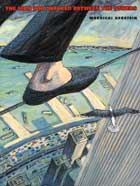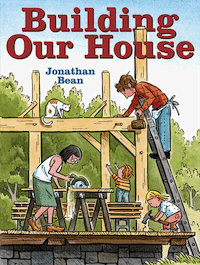The Man Who Walked Between the Towers

by Mordicai Gerstein. ![]() Nonfiction Picture Book. 40 pages. Grades K-9.
Nonfiction Picture Book. 40 pages. Grades K-9.
Find this book: Amazon

Teacher's Guide

Many children's book authors and illustrators grappled with how and if to commemorate the tragedies of 9/11. Mordicai Gerstein chose a beautiful way to do it. His Caldecott Award winner gives us adventure, suspense, delight and, of course, sadness as he tells the story of Philippe Petit, a tightrope acrobat who did indeed walk between the World Trade Towers in 1974.
We first see the towers on the title page, still under construction. The finished towers stand on the first page with the statistics in the text below. We see our tower walker next, a street performer, gazing up at the towers in between doing the stunts that amaze the small crowds he gathers about him.
We don't learn his first name, Philippe, for several pages and we don't learn his full name until the last page, but we learn a bit more about him near the beginning -- how he once walked between the steeples of Notre Dame Cathedral in his home city of Paris. He knew walking between the World Trade Towers was illegal, and, of course, dangerous, but he began his plan to do it. He would disguise himself as a construction worker for the towers were still under construction. Step by step we learn how he and some friends brought the heavy wheel of cable to the roof and hid until night fall; how friends on the other tower tied a line to an arrow and shot it across. Then stronger cables were attached to that line and pulled over. Several times there were near disasters even before Philippe stepped out on the 5/8 inch cable in the predawn darkness.
The perspectives in the book add to the drama. In one you can see the curvature of the earth as the sun rises. The Statue of Liberty is a tiny dot in the harbor. Another brings just the foot of the small man as he steps out onto the cable. Fold out pages, both horizontal and vertical give added dimensions to the story.
Only the last pages hint of the tragedy "Now the towers are gone. But in memory, as if imprinted on the sky, the towers are still there."
(Continued Below)
Advertisement:

Things to Talk About and Notice
- Don't hurry through the book. Take time to appreciate it all: the city at night and throughout the day when Philippe walked back and forth across the cable, eluding the outstretched arms of the police at each end. Imagine where the artist is in each of those views.
- This is a good book for ethics discussions. Philippe knew it was illegal to walk between the towers. Why would anybody care? What danger did he create for himself and for others? There were policemen waiting for him at each end of the cable. Those policemen probably were taken from other duties. What was the cost? What could have been the cost?
- Turn to the 9/11 tragedy itself. Be sure that time is given for talk and for listening.

Activities
- You may want to head for the gym after reading the book together. Children may want to try just walking back and forth on a balance beam set close to the floor to get some sense of Philippe's feat. Try it with balancing poles both rigid and flexible. Try other feats of balance with asymmetrical items in hand.
- Make a list of other daredevil feats -- going over Niagara Falls in various conveyances, rock climbing on skyscrapers, motorcycle, airplane and automobile stunts. Which ones resulted in harm to the stunt person or to others? Which were most hazardous? Did any good come of any of them?
- Go on to discuss bravery. There's no doubt that Philippe was brave, but that's only one kind of bravery. Read Bernard Waber's book Courage (Houghton, 2002. ISBN 0618238557.) and then talk about and list various acts of bravery that you've witnessed or heard about.
- Slide over into math by looking at those statistics about the towers on the first page of the book. They were 1340 feet high. The number is written out so the first task may be translating it into numerals. You might like to try converting that number into as many different measurements as possible: inches, yards, miles, meters, etc. They were the tallest buildings in New York City and so you'll want to find the figures for the second, third, fourth and probably fifth tallest buildings in New York. Go on to find the stats for the tallest buildings in other cities around the world.
- Locating those cities on a map brings you into geography. Stop for a while in Paris and locate Notre Dame Cathedral on a city map. When you find the height of those towers, go back to the figures you've got for the other buildings and start work with some ratio and you're back into math.
- Art is obvious because of both the illustrations in the book and the architecture of those buildings. Look through some magazines for photos of the winning plans for the new buildings in the area of NYC destroyed on 9/11. Read about the various rationales for each plan and for the decision on the winning plan.
- For math activities using this book see the excerpt from our book on using picture books in the math curriculum.
(Continued Below)
Advertisement:

Related Books
- McCully, Emily Arnold. Mirette on the High Wire. (Puffin, 1997. ISBN 0698114434. Order Info.) In 19th Century Paris, a little girl and the great Bellini walk the high wire.
- Wells, Rosemary. Wingwalker. Illustrated by Brian Selznick. (Hyperion, 2002. ISBN 0786803975. Order Info.) In this longer than usual picture book set in the Depression Era, young Reuben who was terrified on the only airplane ride he had gone on, learns that his father has found work at last as a wing-walker on an airplane.
- Petit, Philippe. To Reach the Clouds. North Point Press, 2002. ISBN 0865476519. Order Info. Petit himself wrote this book for adults about his tightrope walk between the towers. Includes great photos.

 Grades PreK - 3
Grades PreK - 3
Building Our House by Jonathan Bean. Picture Book. 48 pages.
Find this book: Local Bookstore, Amazon, B&N
This is an affectionate picture book portrayal of a family building their own home from scratch. Everyone helps over the course of a year and a half while they live on site and the small family grows from two to three children. There are lots of timber frame building details while the focus stays on the warm and loving family creating a home together. A beautiful example of the emotional and material power of teamwork. This book won the Boston Globe Horn Book Picture Book Award for 2013.
(Continued Below)
Advertisement:

Related Areas Within Carol Hurst's Children's Literature Web Site
- Using The Man Who Walked Between the Towers in the Math program with activities
http://www.carolhurst.com/subjects/math/mathmanwhowalked.html - Buildings and Architecture in Children's Books. Featured Subject with books, activities and links.
http://www.carolhurst.com/subjects/buildings.html - Cities and Towns in Children's Books. Featured Subject with books, activities and links.
http://www.carolhurst.com/subjects/citiesandtowns.html - Free Teacher's Guides: A listing of all our teacher's guides. Picture Books, Nonfiction and Fiction.

